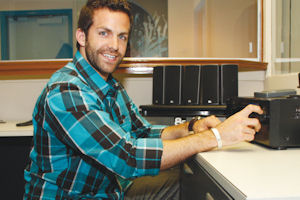Brandon Hance, CEO of Van Nuys-based Audiolife, is out to revolutionize the way musicians sell merchandise. Gone are the days when independent artists have to front the cash to buy inventories of CDs, T-shirts and other items that may or may not sell. “Our (free) web-based platform gives artists a portable store, an e-commerce infrastructure to directly monetize their fans,” said Hance. “It allows them to publish items without ever manufacturing them.” Merchandise is produced on-demand. Artists can download, personalize and post the e-commerce store on sites like Facebook, Twitter, and MySpace. Each order, even for one item, is sent to vendors who manufacture the product and send it directly to fans. Audiolife only makes money when items sell. And to date it has powered close to 50,000 storefronts worldwide, including ones for artists such as Will.i.am, Pussycat Dolls and George Benson. From 300-500 new online stores are publishing daily, said Hance. Direct to fans “It’s a direct-to-fan e-commerce platform, and we provide users all of the data about who’s purchasing the merchandise,” he said. “It’s all about empowerment.” Hance, 27, launched Audiolife in June 2005. The original plan was to create a destination social commerce web site where independent artists could sell merchandise. He and other founders planned on manufacturing CDs and other merchandise in-house. Audiolife secured close to $4 million from Tech Coast Angels and the Coachella Valley Angel Network. The company quickly grew to 50 employees and had music industry veterans on board such as the former CEO of Tower Records. But the company was not able to get over a number of technological hurdles and bring the concept to market. “We were a month away from launching for a year and a half,” said Hance, who used to play quarterback for USC. “At the end of 2008, we moved away from creating a social commerce network, lost a lot of our team and the number of employees dropped to six.” Business model change Audiolife changed its business model and technology to create transportable storefronts versus a destination site. The company contracted with outside vendors/manufacturers nationwide to produce on-demand merchandise. It designed all of its own publishing tools that allow artists to upload or create images that are placed on merchandise. And the company created algorithms that send orders to the vendors who can produce items as fast and inexpensively as possible. Audiolife launched in beta capacity in Feb. 2009. Shortly thereafter, the company teamed with ReverbNation.com, an online music marketing platform used by artists, managers, record labels, and venues. It publicly launched on ReverbNation in March 2010. “Any artist can connect with fans to sell music and products in less than two minutes using the Reverb Store,” said Michael Doernberg, CEO of ReverbNation, in a press release. Artists in control Artists set the final price above the cost and keep 100 percent of the profits from every sale, he added. They can also use the Reverb Store to order larger quantities of CDs and merchandise at discounted wholesale prices. “Brandon is creating a way to support the middle class in the music business,” said Steven Pfrenzinger, member of Tech Coast Angels and lead investor in Audiolife. “There are so many artists who come up to us and think it’s not real.” The first business model stalling turned out to be a good thing, he added, because the popularity and functionality of social networks have increased. And musicians are relying more heavily on selling merchandise to compensate for lower album sales. The music industry is trying to figure out the best way to use the Internet and social networks to sell merchandise. But many are afraid to touch the product manufacturing side. That’s how Audiolife differentiates itself, he said. Audiolife’s revenues and new opportunities are increasing substantially, he added. It recently secured an additional $1 million in bridge financing from angel investors. And the company is exploring opportunities with high-end musicians and how the platform can be used for non-profits and a variety of other businesses. “Music is almost turning into a loss leader to create a following,” said Pfrenzinger.
